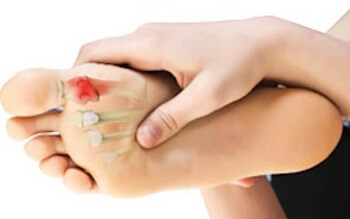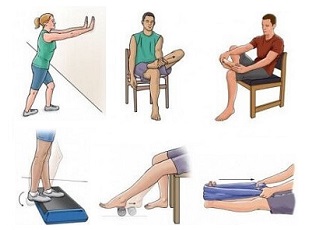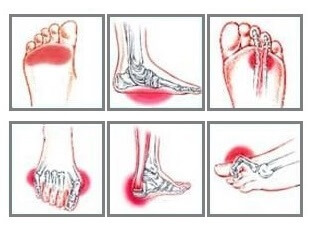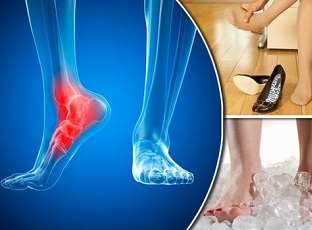- Home
- Diagnosis Guide
- Toe Pain
- Sharp Toe Pain
Sharp Pain In Big Toe
Written By: Chloe Wilson BSc(Hons) Physiotherapy
Reviewed By: FPE Medical Review Board
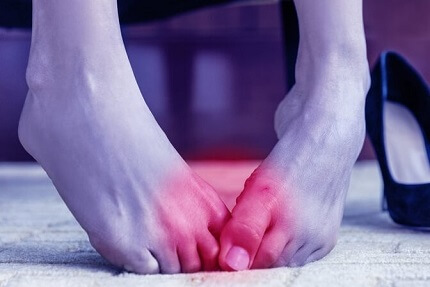
Sharp pain in the big toe can really impact day to day activities.
Anytime we stand, walk or run, our big toe, aka "hallux", is placed under considerable force.
The big toe needs to be able to move freely and plays a vital role in balance.
Indeed around 85% of the control of the foot comes from the big toe and it bears almost twice as much weight as the other four toes combined!
Problems in either the bone of surrounding soft tissues can cause sharp pain in big toe. Toe pain may come on suddenly with and injury or gradually over time for no obvious cause.
What Causes Sharp Pain In Big Toe?
There are lots of possible causes of a sharp pain in the big toe.
Here we start by looking at the most common causes, how they present and how to treat them. Then we go on to look at some of the less common causes of sharp big toe pain. If your pain is also affecting the other toes, check out the toe pain article.
1. Foot Gout
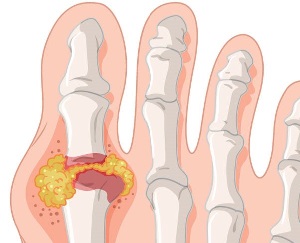
Sudden sharp pain in the big toe is often caused by gout, a specific type of inflammatory arthritis.
Often gout foot only affects the big toe, which is known as podagra, but it may affect the other toes as well.
Foot gout develops when high levels of uric acid form urate crystals in the big toe joint, known as Podagra.
Big toe gout may be caused by a combination of:
- Diet: Food and drink with high purine or sugar levels e.g. red meat, beer and soda
- Obesity: having a BMI over 35
- Medication: such as diuretics, beta blockers and regular aspirin
- Genetics: Your genes may make you more susceptible to foot gout
- Medical Conditions: e.g. high blood pressure, kidney disease, diabetes and high cholesterol
Symptoms of big toe gout tend to develop very suddenly and rapidly, often at night time and usually include:
- Intense Pain: Sharp pain in big toe
- Swelling: at the base of the big toe
- Redness & Heat: In the big toe joint
- Tenderness: to touch or wearing shoes
Sharp pain in the big toe from gout usually lasts 5-10 days. Repeat episodes are unfortunately common, but treatment can help to not only reduce the symptoms of podagra, but also help reduce the risk of recurrence.
Treatment for big toe gout may include a combination of medication, diet and lifestyle changes - find out more in the gout treatment section.
Summary: Foot Gout is likely to be the cause of your sharp pain in big toe if you have intense pain that developed rapidly and is accompanied by redness and swelling around the big toe. Find out more in the Gout Foot section.
2. Sesamoiditis
If your sharp pain in big toe is more underneath the toe, spreading to the foot arches, chances are the problem is Sesamoiditis.
Underneath the big toe are two small, pea-shaped bones known as the sesamoid bones which are surrounded by muscle tendons.
Inflammation of these bones and the surrounding tendons is known as sesamoiditis.
Sesamoiditis is usually caused by overloading the sesamoid bones and over working the surrounding tendons. Typical activities that cause sesamoiditis include
- Activities placing pressure on the big toe e.g. ballet and running
- Wearing high heels or poorly fitting shoes
- Having high foot arches
Sesamoiditis tends to develop gradually over time rather than suddenly and symptoms typically include:
- Pain: dull ache underneath the foot with intermittent sharp pain in big toe
- Stiffness: reduced movement when bending and straightening the big toe
- Swelling & Bruising: under the big toe and on the bottom of the foot
- Difficulty Walking: limping and keeping weight off affected big toe
Sesamoiditis can usually be treated successfully at home with a combination of rest, ice, medication, orthotics, taping and physical therapy. It usually takes around six weeks for the symptoms of big toe sesamoiditis to subside with these treatment methods.
Summary: Sesamoiditis is likely to be the cause if you get intermittent sharp pain in big toe that gets worse when weight-bearing and is accompanied by an underlying background ache underneath the foot. You can find out more in the Sesamoiditis section.
3. Turf Toe
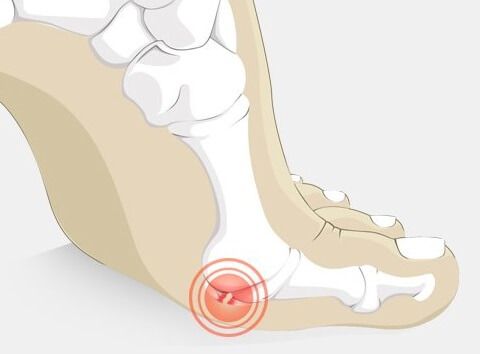
Turf Toe is a sprain of the soft tissues underneath the big toe.
Turf Toe is also referred to as a metatarsophalangeal joint sprain and is a common cause of sudden sharp pain in big toe in athletes.
If the big toe is suddenly forced to bend back too far, then the structures underneath the big toe are overstretched causing them to tear.
Turf Toe typically happens when pushing down through your toes with the heel lifted off the ground.
Turf Toe typically develops when:
- Playing Sports On Rigid Surfaces: e.g. football or soccer as artificial turf is harder and less flexible
- Ballet & Gymnastics
- Sprinting: particularly with the initial push-off
- Quick Movements: Pivoting, jumping and sudden acceleration
At the time of injury, there is immediate sharp pain in the big toe which gets gradually worse over the next day or two. There may also be some swelling and bruising. The severity of the pain underneath the big toe will depend on the extent of the damage.
Treatment for Turf Toe will depend on the severity of the injury and may include a combination of rest, ice, strapping, walking cast and physical therapy - find out more in the Turf Toe Treatment section. Recovery from Turf Toe usually takes 3-4 weeks.
Summary: Turf Toe is the likely culprit if your sharp pain in big toe developed very suddenly underneath the big toe when pushing off through the toes. Find out more in the Turf Toe section
4. Toe Lumps
Many people who experience sharp pain in the big toe also suffer from toe lumps. There may be a small hard lump on the side of the toe, a large soft lump underneath the toe or anything in between.
Toe lumps may develop in:
- Toe Joints: bone lumps can cause the toe's to change position so they end up sticking out and rubbing on your footwear
- On Or Under The Skin: Friction, excess fluid or infection can lead to soft, fluid filled lumps
- On Soft Tissues: lumps may develop around the soft tissues e.g. nerves and tendons causing irritation
When toe lumps get squashed, they often cause a sharp pain in the toe. You can find out all about the different causes, symptoms and how to treat them in the Lumps On Toes section.
Other Possible Causes
We have looked at the four most common causes of sharp pain in big toe, but there are a number of other things that can cause big toe pain including:
- Bunions: big toe shifts towards the second toe forming a hard lump
- Hammer, Mallet or Claw Toe: toes curl into abnormal positions
- Ingrown Toenails: toenails curl and cut into the skin
- Hallux Rigidus: stiff big toe
- Tennis Toe: injury causing bleeding under the nail
- Blisters: from friction or irritation
- Fractures: break in one of the foot bones
- Nerve Pain: irritation of one of the foot nerves, often with tingling or numbness
You can find out loads more about each of these including the causes, symptoms, diagnosis and treatment in the toe joint pain section. And remember, any new onset of sharp pain in big toe should be evaluated by your doctor.
Sharp Pain Big Toe Summary
Sharp pain in the big toe is a common problem that can happen at any age.
The big toe is the most important toe in the whole foot with more than twice as much weight going through it as the other four toes combined.
Sudden sharp pain in the big toe accompanied by redness and intense pain is usually due to foot gout.
Sharp pain underneath the big toe is usually caused by sesamoiditis, inflammation of the two pea-sized bones underneath the big toe.
If the big toe is stretched back too far it can cause sharp pain in the big toe from Turf Toe.
If the big toe is turning inwards over the second toe, it's likely bunions.
If there is a lump on your toe it may be a cyst, corn/callus, mortons neuroma, blister or excess bone.
There are lots of other causes of big toe pain including hammer/mallet/claw toes, hallux rigidus, tennis toe and fractures.
You may also be interested in the following articles:
- Pain On Top Of Foot
- Ball Of Foot Pain
- Foot Arch Pain
- Nerve Pain In The Foot
- Foot & Ankle Stretches
- Swollen Feet & Ankles
- Foot Numbness
- Foot Lumps & Bumps
Related Articles
Page Last Updated: 7th November, 2024
Next Review Due: 7th November, 2026
